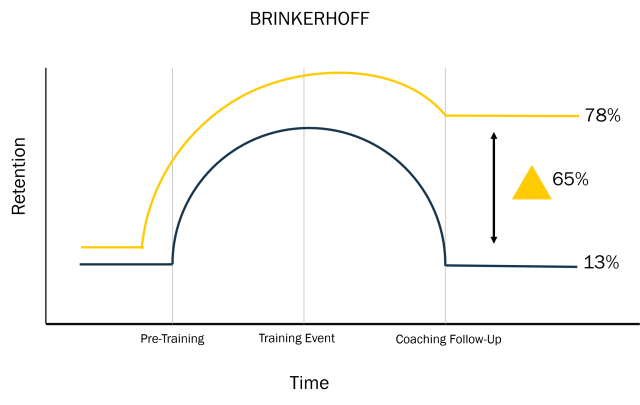

The Achilles heel of every learning and training professional is determining how to help the people we sent to training or trained ourselves to actually change and grow!
The other Achilles heels? Pressure from above to demonstrate measurable growth and return on investment (ROI).
Allow me to share three things that we have always known in talent and organizational development, but now have research to use in our business cases alongside Kirkpatrick, Brinkerhoff and adult-learning theory.
First, newly learned behaviors were understood more deeply and validated by the learners after a few days (up to two weeks) had passed. After letting it sink in, using it on the job and executing the action plans they crafted during the course, learners now had results to share, as well as questions for their coach, as they began applying concepts to multiple situations. Learners began to experience satisfying results, even though not yet to full competency.
Second, it is evident that since learners know the coaching appointment is on their calendar, they keep much of the new learning top of mind so they could intelligently discuss and debrief with their coach. We know that check-ins and coaching create accountability that can present a rise in retention as high as 65% over time.1

Third, reinforcement coaching reveals a powerful two-way street. Talking about the leader’s application of the training and what the followers found they need from their leader provides greater understanding. This understanding always comes when you internalize and identify with the learning not only as the leader but also as the led.
Talent development professionals have discovered the value of cohorts, a group with similar skill level and learning needs, going through a schedule of courses or curriculum together. Get the cohort back together within two to four weeks to discuss how the application of the learning has been going on the job. Ask one or two ahead of time to bring a use-case scenario they can share for the group to work through together. Remember, other than a brief review at the beginning you are not a teacher here but a facilitator. Repeat in two to four weeks with three times being your goal.
Break the larger cohort into subgroups. Get this group of three to six together in a similar fashion to the large group. When a group like this clicks, they begin to run themselves and set a cadence for their discussions on their own. Your involvement as a trainer or facilitator also decreases as they own the application of the content more and more, consulting you now as a coach.
Encourage pairs who have worked together during the training to put a follow-up meeting in their calendars for two to five days after the training. This is ideal when an action plan was developed during the training around a current situation. Encourage the partners to see how it went and perhaps continue to coach and support each other as sounding boards, role-play partners and trusted peer coaches.
Schedule a 15-minute touchpoint to hear how the application is going. Ask for a situation where the recent learning could apply and be prepared with thought-provoking questions (not answers!) that will cause them to connect possible action with their new tools and behaviors. Repeat with as many of the graduates as you feasibly can.
Seek endorsements from graduates. As you observe shining stars, adopt and apply concepts with success in their work and engage them as champions for the training. This can take on the following forms:
These strategies not only facilitate paths to the training pull-through we are all looking for, but they also develop and embed a healthy “coaching culture” for learning accountability in your organization.